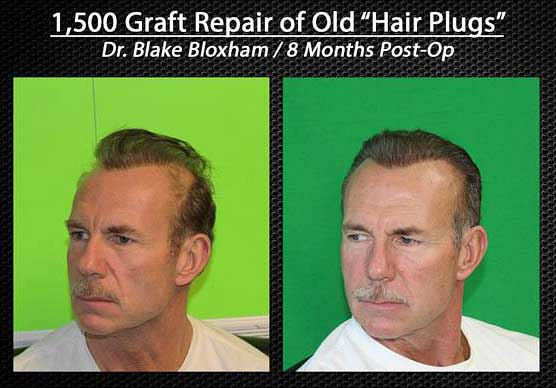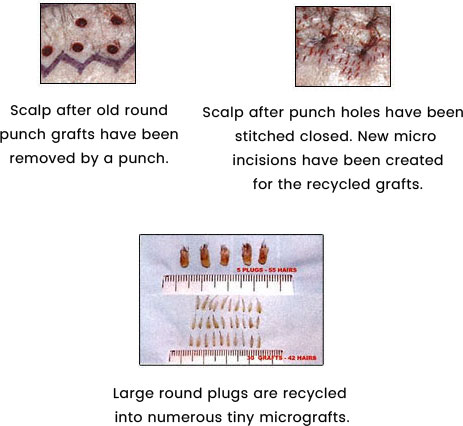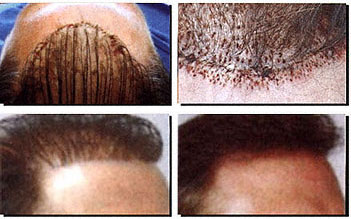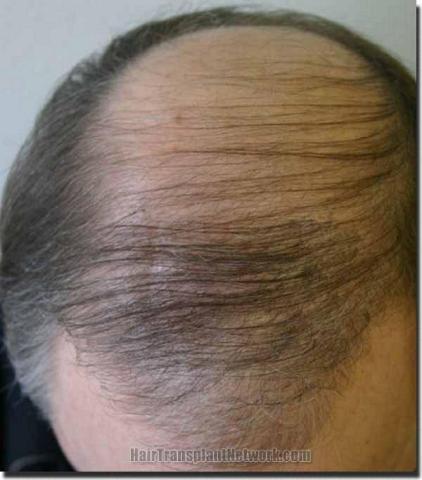
Today hair transplant surgery can achieve results that are so natural they are undetectable, even by a barber or stylist.
However, many early hair transplant techniques that used hair “plugs”, large grafts or minigrafts that are not aesthetically acceptable by today’s standards.
Many who have had these older hair transplant techniques can now complete or repair their previous hair transplants using today’s very refined hair restoration techniques. After hair transplant repair patients can typically achieve a natural look that they can style in any manner.
The below photos show examples of out dated or poor hair transplants results that have been repaired/updated with today's new techniques.
This section shows in detail the various surgical techniques available today for hair transplant repair such as masking, recycling grafts, and/or excising the hairline.

Various Hair Transplant Repair Techniques.
1. Masking large grafts with micrografts.
Some physicians will simply attempt to mask the old plug grafts by surrounding them with today’s smaller and more refined micrografts. This can be effective if the older grafts are not too close to the hairline. A patient must also have a sufficient number of micrografts available to surround and mask these larger grafts.
However, if a patient’s large grafts are too low on the hairline or if there are not sufficient micrografts available to mask them they should be carefully removed.

2. Removing and recycling large grafts into small grafts.
Often a patient’s previous hair transplant grafts cannot simply be masked by surrounding them with smaller and more refined micrografts. These large grafts should be surgically removed and recycled into small micrografts that can then be retransplanted.
To do plug reduction and recycling a physician begins by removing the large round plug grafts. Typically a round punch instrument is used to excise these obvious larger round grafts. This punch graft is normally the same size or smaller than the one used to originally create and place these round punch grafts.
Some times a small part of the large graft is left in the scalp, thus leaving behind a smaller graft. Often the round holes left after the round grafts are punched out are then stitched closed.

The hair plug or part of the hair plug that was removed is then carefully dissected into tiny micrografts that contain one, two, three, and sometimes four hair follicular units.
These refined micrografts are then retransplanted into tiny incisions around the excised punch grafts. Often a surgeon will harvest additional tissue from the donor area to create additional micrografts. When these tiny micrografts grow out they will recreate a natural and refined distribution of hairs in place of the previously unnatural "pluggy" grafts.
Some times a small part of the large graft is left in the scalp, thus leaving behind a smaller graft. Often the round holes left after the round grafts are punched out are then stitched closed.
3. Repair of outdated and or poor graft placement using scalp surgery.
In extreme situations where the hairline was placed unnaturally low or the temple areas are blunted with no natural recession, scalp surgery may be required to raise the hairline and remove the offending grafts.
The patient shown below has a hairline that is not only "pluggy" but placed too low, with no natural recession in his temple areas. Simply removing the round plug grafts would not remedy this patient's unnaturally low hairline because he would then have visible scarring in his forehead area below the hairline.

This patient opted to do a surgery that first lifted his hairline higher, while recreating a natural recession in his temple areas.
The row of pluggy grafts that are too low are first surgically removed in one thin strip. The grafts in this removed strip were then immediately recycled into small grafts for retransplantion.
The patient's forehead skin was then pulled upward and seamlessly sutured. This surgery raised the man's hairline by about 1.5 cm and restored the recession in his temple areas. A rejuvenating browlift was a bi-product of this surgical hairline correction.
Tiny follicular unit micrografts are then placed in front of the linear incision to create a refined and feathered hairline.
Once the newly transplanted hair grew out the patient achieved a hairline that was vastly more refined and also positioned higher on the forehead in a much more natural manner.
Hair Transplant Repair - restoring hair and restoring lives.
Patients who suffer from inadequate previous hair transplants are encouraged to seek expert medical advice and correct their outdated or inadequate work. Today there is no reason for patients to continue to suffer from an unnatural and embarrassing appearance.
Understandably, many patients who have had a painful and negative experience with hair transplant surgery are reluctant to seek help. But they often get a new lease on life when they discover what can now be done to restore both their natural hair and often their normal life.
Special thanks to Dr. James Vogel of Maryland for contributing his photos and world renowned expertise for this repair section.

















